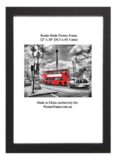We generally say, no, you don't really need to get your Asian painting stretched and then framed . Frequently, when they v isit us, they say that they have just returned from an Asian holiday, from Bali, Thailand or India. They tell us that they have a valuable, original, often large oil painting that needs framing. Frequently, they seem to have been regaled with tall tales of the worth of the paintings they have bought. They appear to believe, or are under the impression, that their oil painting is quite valuable and that it should be stretched first and then framed. Sometimes they specify ...
isit us, they say that they have just returned from an Asian holiday, from Bali, Thailand or India. They tell us that they have a valuable, original, often large oil painting that needs framing. Frequently, they seem to have been regaled with tall tales of the worth of the paintings they have bought. They appear to believe, or are under the impression, that their oil painting is quite valuable and that it should be stretched first and then framed. Sometimes they specify ...
that they do not want a cheap strainer frame, but a proper stretcher frame, with adjustable tension keys. When we inquire as to the approximate worth or the painting, we are often told that it was a real bargain for a mere USD100 or USD200. And this is when our antennae go up and the alarm bells start ringing. These painting are often signed with artists’ with Western names, Brewster, Harrison, Olsen, and what have you.
The subject maybe Buddha heads, Asian tigers, Asian elephants, lurid sunsets or Parisian streetscapes. All these are giveaway clues to the strong possibility that the valuable painting may not be valuable at all. This likelihood becomes more probable when the paintings are unrolled and stretched out onto the picture framer’s counter and there’s no smell. Genuine oil paintings often have a distinctive and strong oily smell, much like after a painter finishes painting your house’s woodwork, you smell this as soon as you walk in .
In both instance the paint is oil based, and it will smell, and quite strongly too. However genuine painting oils are far more expensive than water-based paints such as ceiling paint. which is about 40 to 55 times cheaper than tubed oil colours. To put in another way, a tiny 37 ml of oil colour tube may cost around USD9 where as a litre ( 27 times as much ) of water base paint may cost around USD5.
If you were a poor, starving Balinese artist, living hand-to-mouth, trying to sell his art at Kuta beach, which paint would you buy and use? This is the reason why a lot of the “valuable” painting brought to us by returning holidaymakers from overseas for framing don’t smell, they’ve been painted in the cheapest painting available. Well, might you say, so what that the painting hasn’t been painted in genuine oil colours but in cheap ceiling paint instead, it still looks fine to you, right?
Key Differences Of Acrylic Paintings Versus Oil Paintings
Perhaps but house paint generally performs poorly as artists' acrylic paint because of durability, fading and discolouration problems More importantly, house paint is not elastic, but rigid and brittle with fillers and chemical additives, making it prone to cracking and flaking. Therefore a water-based, acrylic painted canvas cannot be folded, wrapped and stretched over the stretcher bars because all the edges will crack on all four sides. We actually keep a sample of a trimmed off-cut of such a canvas to demonstrate to our customers what happens when the canvas is folded.
When we do this, the sample canvas strip readily cracks and the acrylic paint crumbles as in the example below. And this is why it's not really worth to pay to have this type of Asian painting stretched and then framed:

When such a painting is brought to our picture framers for stretch-framing, they invariably recommend against this because of the reasons stated herein. What we do suggest, for this particular type of canvas painting, is to wet-mount and vacuum-press the painting a sheet of 3mm MDF of similar stratum. This is a reliable and inexpensive method to keep the painting firmly, solidly and permanently affixed to the surface of a backing board.
After the wet-mounting has dried, the backing board with the painting can then be framed. And if you are worried that this is a more expensive method than stretch-framing, relax it’s not, and it’s actually cheaper. The reason why is this is so is because there only need to be one frame made, against the two of the traditional frame eg; the stretcher frame and the outer frame. Please note that if you are wanting to put your painting in a ready-made poster frame, we don't recommend it because the canvas wouldn't look right unmounted.
Where Most Paintings Really Come From
Returning to the subject of oil paintings, and to take this further, an oil painting could very well feel and smell like a real oil painting because it is a genuine oil painting. But if it is inexpensive, purchased in Asia and is a replica or reproduction of famous or well known European or Western artists, then it is quite likely that it was mass produced as shown below:

However even if it is a genuine oil painting, if it is mass produced, then the same wet-mounting, or gluing down method, would be the most common sense way of framing it. If unsure as to what can be done, or seeking further information, please contact us. As a closing note, if any oil painting or artwork, of any genre or provenance, bears, has, carries or possesses any sentimental, financial, historical or personal value to its owner, then it should not be wet-mounted but professionally stretched and framed. Thank you for reading this post "Should I really be getting get my souvenir Asian painting stretched and then framed?".
What To Do And Not To Do When Framing Paintings On Canvas
| List of Do's | List of Don'ts | ||
| ✓ | Do smell your canvas painting before buying it. If it has a strong, oily, smell it's most likely a genuine oil painting. If not, then it's been painted using acrylic paints and stretching is not recommended. | ❌ | Don't buy Australian landscapes in rolled up canvases signed by a Jones or a Smith in a pub and being reassured that they're from young, promising, talented bush artists. Chances are that these are what in the trade are called 'Hong-Kong" paintings. mass-prrduced in Asia and signed with bogus Western names. |
| ✓ | Do get your canvas framed as soon as you can. Keeping stored rolled up in a tight tube is not only unhelpful to good stretching, it can actually hinder it. | ❌ | Don't buy an Asian-made painting at a low, bargain price and then expect to get it framed cheaply in Australia. Many Customers who bought a painting for $100 are shocked to be told that to get it stretched and float framed can cost 6 to 10 times as much. |
| ✓ | Do ask for a genuine stretcher frame rather than a strainer frame if your art is valuable. Stretcher frames have keys for tightening slack and loose canvases. Strainer frames do not. | ❌ | Don't try to save money by framing your canvas in a department store or ready-made frame. Canvas is much heavier than paper and sags horribly if simply put under glass. The canvas has to be and remain, firm, taut and flat. This can only be achieved by mounting it or stretching it. |
| ✓ | Do wait a while to get genuine oil paintings framed. The white oxides in genuine artists' oil painting can take a long as two years to dry. If unsure, contact the artist for instructions. | ❌ | Don't try to save on cost by trying to mount a canvas on plywood or Masonite with spray adhesives. These sprays don't work adhere too well to canvases and fabrics. People try hard and mean well with these adhesives but these just won't hold permanently. |









There are all sorts of picture framers out there. Most are honest framers but some are just salesmen. I got back from Bali with four big paintings I wanted framed. The first city picture framer I went to, where I work, gave me a song and dance about me having to get my paintings properly and professionally framed to "safeguard" them he said, the cost ? Around 2,100 all up. I left there and later on popped into my local picture framer who gave me a much more reasonable quote, under $500 all up. The first framer gave me a conservation framing quote, the second one, a normal framing quote with the paintings glued down. Naturally I went ahead with the normal quote. 12 years later the cheaply framed paintings still look fine.